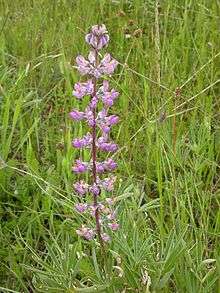Lupinus sulphureus
| Lupinus sulphureus | |
|---|---|
 | |
| Lupinus sulphureus ssp. kincaidii | |
| Scientific classification | |
| Kingdom: | Plantae |
| (unranked): | Angiosperms |
| (unranked): | Eudicots |
| (unranked): | Rosids |
| Order: | Fabales |
| Family: | Fabaceae |
| Subfamily: | Faboideae |
| Tribe: | Genisteae |
| Genus: | Lupinus |
| Species: | L. sulphureus |
| Binomial name | |
| Lupinus sulphureus Douglas ex Hook. | |
Lupinus sulphureus (sulphur lupine, sulphur-flower lupine)[1] is a species of lupine, a flowering plant of the legume family, Fabaceae. It is native to western North America from southern British Columbia south through Washington to Oregon. It is a perennial herbaceous plant growing to 40 to 80 cm tall. The leaves are palmately compound, with 7 to 13 leaflets each 2 to 5 cm long. The flowers are produced in whorls on a spike 12 to 20 cm long.
Taxonomy
There are three subspecies:
- Lupinus sulphureus subsp. kincaidii (Kincaid's lupine; syn. L. oreganus subsp. kincaidii). Willamette Valley of western Oregon and parts of southwestern Washington. Flowers purple. Threatened.
- Lupinus sulphureus subsp. subsaccatus. Southern British Columbia south to Oregon. Flowers yellow.
- Lupinus sulphureus subsp. sulphureus. Eastern Washington and eastern Oregon. Flowers yellow.
Ecology
Fender's blue butterfly, an endangered species, is host-specific on Kincaid's lupine. Its larvae eat the leaves during the fall and spend the winter among the roots. In spring, the larvae continue to feed on the leaves before pupating.
References
- ↑ Lupinus sulphureus. NatureServe. 2012.
External links
- Lupinus sulphureus. Germplasm Resources Information Network (GRIN).
- Lupinus sulphureus. Plants of British Columbia.
- Lupinus sulphureus. Burke Museum. University of Washington.
- Lupinus sulphureus. USDA PLANTS.
- Lupinus sulphureus subsp. kincaidii. (as L. oreganus subsp. kincaidii). USDA PLANTS.
This article is issued from Wikipedia - version of the 4/24/2016. The text is available under the Creative Commons Attribution/Share Alike but additional terms may apply for the media files.
